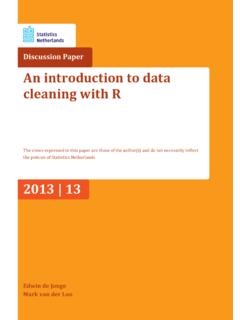Transcription of An Introduction to Statistics - cvut.cz
1 An Introduction Descriptive Descriptive vs. Inferential.. Means, Medians, and Modes.. Variability.. Linear Transformations.. Position.. Dispersion Percentages..72 Graphs and Histograms.. Introduction .. Medians, Modes, and Means Revisited.. z-Scores and Percentile Ranks Revisited.. Stem and Leaf Displays.. Five Number Summaries and Box and Whisker Displays..123 Introduction .. Random Variables.. Definition.. Expected Value.. Variance and Standard Deviation.. Shortcuts for Binomial Random Variables.
2 1814 Probability Binomial Distributions.. Poisson Distributions.. Definition.. As an Approximation to the Binomial.. Normal Distributions.. Definition and Properties.. Table of Normal Curve Areas.. Working Backwards.. As an Approximation to the Binomial..265 The Population The Distribution of Sample Means.. Confidence Interval Estimatess.. Choosing a Sample Size.. The Hypothesis Test.. More on Errors.. Type I Errors and Alpha-Risks.. Type II Errors and Beta-Risks.. Comparing Two Means.
3 Confidence Interval Estimates..352 Chapter 1 Descriptive Descriptive vs. InferentialThere are two main branches of Statistics : descriptive and inferential. Descrip-tive Statistics is used to say something about a set of information that has beencollected only. Inferential Statistics is used to make predictions or comparisonsabout a larger group (a population) using information gathered about a smallpart of that population. Thus, inferential Statistics involves generalizing beyondthe data , something that descriptive Statistics does not distinctions are sometimes made between data types.
4 Discrete data are whole numbers, and are usually a count of objects. (Forinstance, one study might count how many pets different families own; itwouldn t make sense to have half a goldfish, would it?) Measured data , in contrast to discrete data , are continuous, and thus maytake on any real value. (For example, the amount of time a group of chil-dren spent watching TV would be measured data , since they could watchany number of hours, even though their watching habits will probably besome multiple of 30 minutes.) Numerical data are numbers.
5 categorical data have labels ( words). (For example, a list of the prod-ucts bought by different families at a grocery store would be categoricaldata, since it would go something like{milk, eggs, toilet paper, ..}.) Means, Medians, and ModesIn everyday life, the word average is used in a variety of ways - battingaverages, average life expectancies, etc. - but the meaning is similar, usually3the center of a distribution. In the mathematical world, where everything mustbe precise, we define several ways of finding the center of a set of data :Definition 1: median is the middle number of a set of numbers arranged innumerical order.
6 If the number of values in a set is even, then themedian is the sum of the two middle values, divided by median is not affected by the magnitude of the extreme (smallest or largest)values. Thus, it is useful because it is not affected by one or two abnormallysmall or large values, and because it is very simple to calculate. (For example,to obtain a relatively accurate average life of a particular type of lightbulb, youcould measure the median life by installing several bulbs and measuring howmuch time passed before half of them died.)
7 Alternatives would probably involvemeasuring the life of each bulb.)Definition 2: mode is the most frequent value in a set. A set can have morethan one mode; if it has two, it is said to be bimodal. Example 1:The mode of{1, 1, 2, 3, 5, 8}is modes of{1, 3, 5, 7, 9, 9, 21, 25, 25, 31}are 9 and 25. Thus, the set isbimodal. The mode is useful when the members of a set are very different - take, forexample, the statement there were more Ds on that test than any other lettergrade (that is, in the set{A, B, C, D, E}, D is the mode).
8 On the other hand,the fact that the mode is absolute (for example, and 3 are considered justas different as 3 and 100 are) can make the mode a poor choice for determinga center . For example, the mode of the set{1, , , , , , , , }is , even though there are many values that are close to, but notexactly equal to, 3: mean is the sum of all the values in a set, divided by the numberof values. The mean of a whole population is usually denoted by ,while the mean of a sample is usually denoted byx. (Note thatthis is the arithmetic mean; there are other means, which will bediscussed later.)
9 4 Thus, the mean of the set{a1, a2, , an}is given by =a1+a2+ +ann( )The mean is sensitive toanychange in value, unlike the median and mode,where a change to an extreme (in the case of a median) or uncommon (in thecase of a mode) value usually has no disadvantage of the mean is that a small number of extreme values candistort its value. For example, the mean of the set{1, 1, 1, 2, 2, 3, 3, 3, 200}is24, even though almost all of the members were very small. A variation calledthetrimmed mean, where the smallest and largest quarters of the values areremoved before the mean is taken, can solve this VariabilityDefinition 4: range is the difference between the largest and smallest valuesof a range of a set is simple to calculate, but is not very useful because it dependson the extreme values, which may be distorted.
10 An alternative form, similarto the trimmed mean, is the interquartile range, orIQR, which is the range ofthe set with the smallest and largest quarters removed. IfQ1 andQ3 are themedians of the lower and upper halves of a data set (the values that split thedata into quarters, if you will), then theIQRis simplyQ3 useful for determining outliers, or extreme values, such as theelement{200}of the set at the end of An outlier is said to be anumber more than belowQ1 or 5: variance is a measure of how items are dispersed about theirmean.




